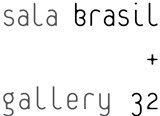
detail of 'Skira', 2010
paper collage on aluminium

detail of 'Hallway', 2009
watercolour collage on aluminium, 154 x 700 cm
watercolour collage on aluminium, 154 x 700 cm
R. Silvio Romero, 34 DEZ/09 I, 2009
inkjet print and collage on aluminium and residue from the studio space | 158 x 150 cm each
R. Silvio Romero, 34 DEZ/09 II, 2009
inkjet print and collage on aluminium and residue from the studio space | 158 x 150 cm each
(images courtesy the artist)
(images courtesy the artist)
The Embassy of Brazil in London proudly presents a solo exhibition by Daniel Senise, one of the major talents to have emerged from what became known as the 'Geração 80' (1980s Generation) in Brazilian painting. The artists of 'Geração 80' were part of a worldwide return to painting, a movement which took the form of Neo-expressionism in Germany, 'Transavantgarde' in Italy, and, in the United States, brought forth a large number of works of great dimensions with runny paint and with large areas of pictorial mass. Senise, though, has developed a body of work that goes much further than the issues raised during that period, creating paintings that relate directly to both history of art and architecture.
In this solo exhibition, organised in collaboration with São Paulo's Galeria Vermelho, the artist presents three recent works, all of which were finished in 2009. The title Skira was inspired by the French publisher Albert Skira, whose art books became known for the outstanding quality of their reproductions. This was achieved by the craft of printing each work individually, on small pieces of paper and then affixing them manually in his editions, creating thus a kind of album, or collection.
The emptiness left on the pages by the pictures removed by he artist has become a dynamo for Senise, instigating him to produce the Skira series, initiated in 2008. Once the illustrations were removed from the pages, a difference in the shade of the colour of those pages became visible. The collages that the artist makes with those pages exploit the chromatic gradation in order to construct façades of a building, using the books as a basis. This reminds us of the brise-soleil – a fundamental element in Brazilian Modernist architecture from the 1950s onwards, which, similarly to Skira, originated in France. In this series, Senise intermingles his relationship with history of art and with a sense of absence – present in important works such as Ela que não está (She, who is not) and Retrato da mãe do artista (Portrait of the artist's mother) – as well as with architecture, which has always been crucial in his practice.
In Hallway, Senise presents a large panel made up of 546 small watercolours, which reproduce the wooden parquet flooring in the hallway of the artist’s house in the district of Arpoador, Rio de Janeiro. This work blends two important pathways in the artist's trajectory: the painting at the beginning of his career and its relationship with floors.
'Hallway' - installation view
installation view
This text will be replaced
download press release









No comments:
Post a Comment